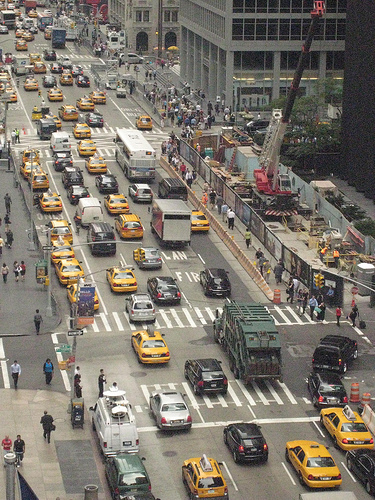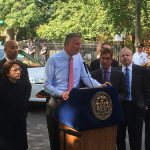Vision Zero looks ahead to 2024

Mayor De Blasio’s Vision Zero campaign is aiming to eliminate traffic fatalities by 2024. Good thing he’s giving himself some time, because New York City is nowhere near that mark. From Scott McLeod.
No wonder New York’s civic leaders want to fast forward to 2024: 286 people died in traffic accidents in the city in 2013. That’s almost the number of homicide victims there in the same period. By 2024, however, that figure will be zero — or so Mayor Bill de Blasio promises through Vision Zero, his initiative that seeks to eliminate traffic-related deaths and serious injuries in the next two decades.
Named after a traffic-safety principle first introduced in Sweden, Vision Zero marries safety improvements with far-ranging public education to not only increase awareness but also to reduce traffic deaths. Ads about the effort have already begun playing on taxi-cab TVs and local channels, and last month the city council passed eleven bills that support Vision Zero goals.
The new regulations span a range of actions from banning driving stunts like wheelies and donuts to requiring the city to fix or replace broken traffic signals within 24 hours after they’ve been reported. The legislation also cracks down on offending motorists; drivers who hit a pedestrian or bicyclist who has the right away will be subject to stricter penalties.
Cabbies also received attention. A mandate known as “Cooper’s Law”— named for Cooper Stock, a nine-year-old killed by a cab on the upper West Side — allows the city to immediately suspend the license of a cab driver who injures or kills someone while committing a traffic violation. The Taxi & Limousine Commission (TLC) will also be able to combine license points issued by the DMV and its own agency when determining whether a driver will be able to retain his or her license.
Not surprisingly, the taxi industry have described the regulations as unfair persecution. “We’ve been targeted when, in fact, [taxi] drivers have the best driving records in the city of New York,” said Bhairavi Desai of the New York Taxi Workers Alliance.
But councilman Ydanis Rodriguez (D-Manhattan), chair of the transportation committee, made no apologies for the legislation. “We, as a city, are stepping up to challenge the epidemic of traffic violations we have faced for too long,” he said. “For drivers who fail to obey the laws of the road, we will hold you accountable.”
The tough talk could only go so far, however, because the state, not municipalities, regulates traffic speeds. It also determines the speed and red-light camera programs of local governments.
So, although New York City wants to lower speed limits to 20 mph in seven designated “slow zones” and to up the number of its speed and red-light cameras, it needs the approval of Albany to do so. Given the state’s long history of quashing the city’s transportation reforms, the council’s attempts may very well fall flat.
But speaker Melissa Mark-Viverito displayed optimism, citing Albany’s recent approval of 120 new speed cameras for New York City, which currently has just twenty.
“We want to change the culture of how drivers, pedestrians, and cyclists interact,” said Rodriguez.
Related Posts
Category: Regulations

















